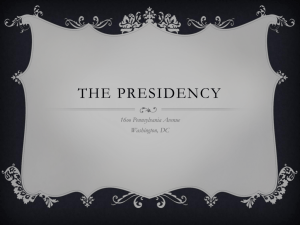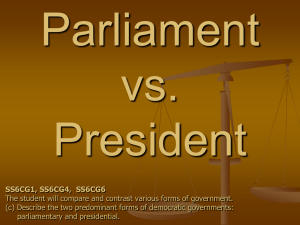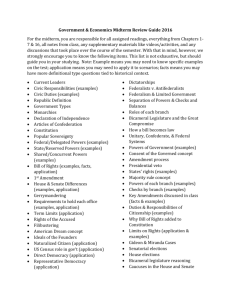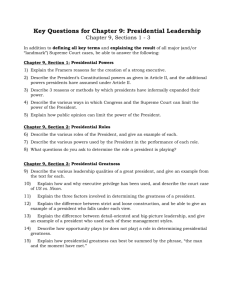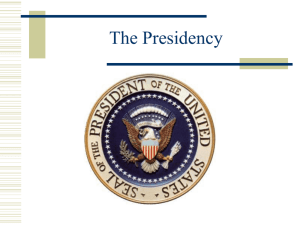Chapter 9: Executives
advertisement
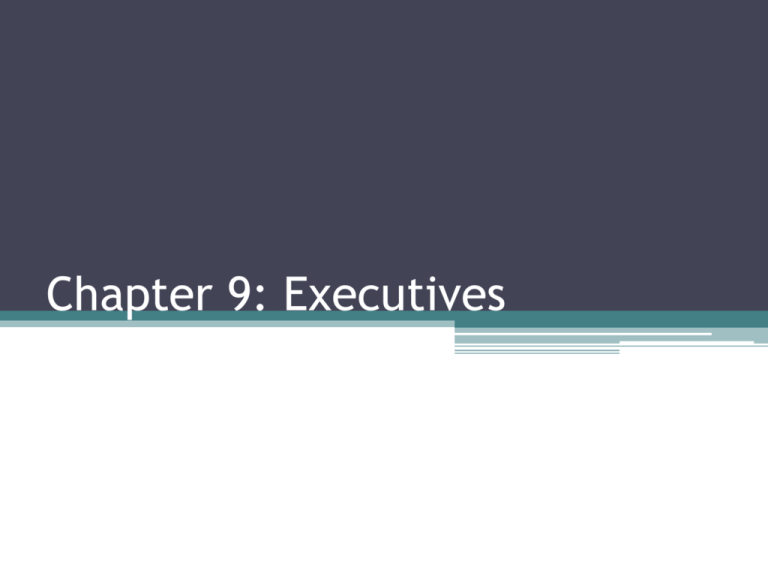
Chapter 9: Executives This Week… • What is the executive branch? • How is the Executive Organized? ▫ Parliaments, Presidents and Mixed Systems • Formal and Informal Powers (and limits on these powers) • Stability and Instability in the Executive What is the Executive Branch? • Branch of government that executes laws ▫ Administers/enacts laws or policy • Executive has policy making rules ▫ Fused powers ▫ Budgetary issues ▫ Policy preferences • Power relationships between legislative and executive branches is variable by system What is the Executive Branch? 2 • Executive often held accountable for quality of services ▫ Run the bureaucracy • Heads of State ▫ Symbolic leader of the states (Ex. Queen, some Presidents) • Heads of Government ▫ Forms government, policies ▫ Runs the day to day business of state (Ex. Prime Ministers) • Dual Executives What is the Executive Branch? 3 • Given power over bureaucracy, executive could be considered most powerful branch • When democracy fails, Executives usually remain • Executives have political and non-political components Presidential Systems ▫ Important note: Just because a country has a president, DOES NOT MEAN it’s necessarily a presidential system (e.g. India) • Direct(ish) election for the President ▫ ▫ ▫ ▫ ▫ ▫ Can be plurality or majoritarian election Fixed term Strict, constitutional separation of powers Cannot propose laws (but can veto) Demands compromise Impeachment Parliamentary Systems • Election of Members of Parliament ▫ Members of Parliament choose Head of Government: Prime Minister/Premier/Chancellor ▫ Indirect Election ▫ Prime Minister is usually the leader of the largest party, chosen before an election – so, most voters know who PM will be ▫ Head of State usually a Figure Head Parliamentary Systems 2 • What else? ▫ Often leaders must be negotiated in incidence of Minority Government ▫ Fused powers ▫ Confidence votes/Responsible Government ▫ Party discipline ▫ Executive Dominance Semi-Presidential Systems • Directly elected president • Prime Minister responsible to legislature, but also President • President can often fire PM • As such, Presidents can be de facto Head of Government Types of Formal Power in Constitutions • Powers can vary across states ▫ ▫ ▫ ▫ ▫ Veto Power Power of Dissolution Decree (usually undemocratic) Executive Order (democratic version of Decree) States of Emergency Formal Limits on Power • Impeachment • Censure • Non-Confidence • Term Limits • But, the legislature needs to act responsibly Partisan Powers • Often times more important than formal powers • Power of legislature in part dependent on control of executive over individual members of legislature • Primaries Coalition Governments • Coalitions are when two or more parties actively work together to govern ▫ Usually in parliamentary systems ▫ Presidential systems can use it (Brazil) • Many electoral systems limit majority governments • Junior Members and Cabinet Coalition Governments Cont… • Coalitions can be complicated ▫ Do not need to have the largest party involved ▫ Can be made up of many different parties • Minimum Winning Coalitions ▫ ▫ ▫ ▫ ▫ Minimum Connected Coalitions Minimum Size Coalitions Minimum Number of Parties Coalition Median Party Coalition Grand Coalition • Failing to win a majority does not require a coalition Informal Powers of the Executive • Influence debate ▫ Make speeches with broad audience • Power to persuade • Patronage • Clientelism (these last two are bad) Stability • Long standing debate about which system of governance is better • Parliamentary system often seen as more effective: ▫ ▫ ▫ ▫ ▫ Clear legitimacy No fixed elections Broader coalition of interests “Presidential” styles tend to be more authoritarian Insider executives Presidential Systems and Democratic Consolidation • Some argue that observations of more stability of parliamentary systems is an issue of wealth, not style of government • Presidential systems due tend towards delegative democracy • Populism and the economy • Strong central governments and the economy Parliamentarism and Instability • Because PMs can be fired, there can be high levels of turn over • Systems that tend towards minority governments can also result in turnover ▫ Sometimes without elections • Italy



